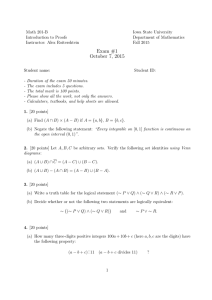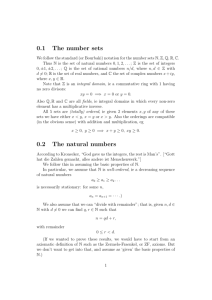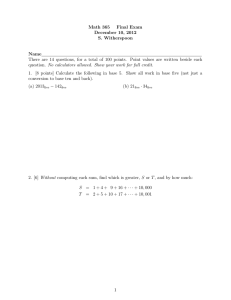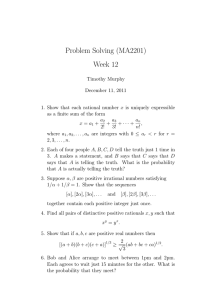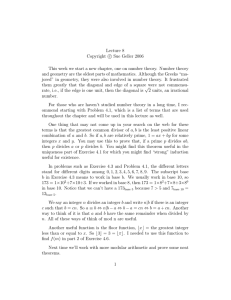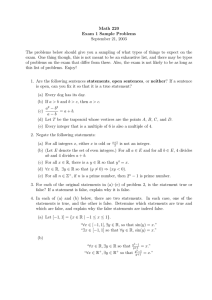Math 201-B Iowa State University Introduction to Proofs Department of Mathematics
advertisement
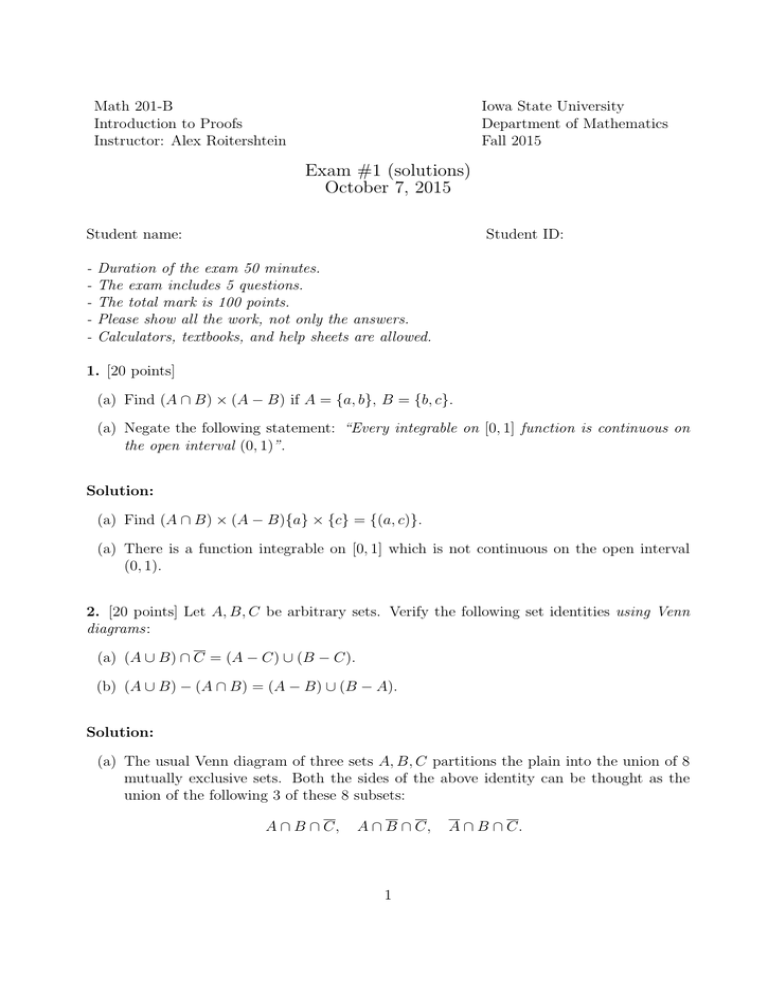
Math 201-B
Introduction to Proofs
Instructor: Alex Roitershtein
Iowa State University
Department of Mathematics
Fall 2015
Exam #1 (solutions)
October 7, 2015
Student name:
-
Student ID:
Duration of the exam 50 minutes.
The exam includes 5 questions.
The total mark is 100 points.
Please show all the work, not only the answers.
Calculators, textbooks, and help sheets are allowed.
1. [20 points]
(a) Find (A ∩ B) × (A − B) if A = {a, b}, B = {b, c}.
(a) Negate the following statement: “Every integrable on [0, 1] function is continuous on
the open interval (0, 1)”.
Solution:
(a) Find (A ∩ B) × (A − B){a} × {c} = {(a, c)}.
(a) There is a function integrable on [0, 1] which is not continuous on the open interval
(0, 1).
2. [20 points] Let A, B, C be arbitrary sets. Verify the following set identities using Venn
diagrams:
(a) (A ∪ B) ∩ C = (A − C) ∪ (B − C).
(b) (A ∪ B) − (A ∩ B) = (A − B) ∪ (B − A).
Solution:
(a) The usual Venn diagram of three sets A, B, C partitions the plain into the union of 8
mutually exclusive sets. Both the sides of the above identity can be thought as the
union of the following 3 of these 8 subsets:
A ∩ B ∩ C,
A ∩ B ∩ C,
1
A ∩ B ∩ C.
(a) The usual Venn diagram of two sets A, B partitions the plain into the union of 4
mutually exclusive sets. Both the sides of the above identity can be thought as the
union of the following 2 of these 4 subsets:
A∩B
and A ∩ B.
3. [20 points]
(a) Write a truth table for the logical statement (∼ P ∨ Q) ∧ (∼ Q ∨ R) ∧ (∼ R ∨ P ).
(b) Decide whether or not the following two statements are logically equivalent:
∼ (∼ P ∨ Q) ∧ (∼ Q ∨ R)
and
∼ P ∨ ∼ R.
Solution:
(a) Because of its “cyclic structure”, the logical statement is true in only two out of eight
possible scenarios:
either P is True, Q is True, R is True,
or
P is False, Q is False, R is False.
(b) The statements are not logically equivalent. For instance, if P is True, R is True, Q is
False, then
(∼ P ∨ ∼ R) is False
while
∼ (∼ P ∨ Q) ∧ (∼ Q ∨ R) is True.
4. [20 points]
(a) How many three-digits positive integers 100a + 10b + c (here a, b, c are the digits) have
the following property:
(a − b + c) | 11
?
(b) How many three-digits positive integers either have the above property or are multiples
of 10?
Solution:
2
(a) It is not hard to verify that since a ∈ {1, 2, . . . , 9} and b, c ∈ {0, 1, 2, . . . , 9},
(a − b + c) | 11
⇔
(a − b + c) ∈ {0, 11}.
(a − b + c) | 11
⇔
(a + c) ∈ {b, 11 + b}.
Equivalently,
For a given b ∈ {1, 2, . . . , 9} there b feasible solutions to a + c = b, namely (a, c) has
the form (k, b − k) with k ∈ {1, . . . , b}. We thus have
1 + 2 + 3 + . . . + 9 = 45
feasible solutions to a + c = b.
Similarly, for a given b ∈ {0, 1, . . . , 7}, if a + c = 11 + b then
(a, c) ∈ (2 + b, 9), (3 + b, 8), . . . , (9, 2 + b) .
Thu, for a given b, we have 9 − (2 + b) + 1 = 8 − b solutions to a + b = c. In total we
have
(8 − 0) + (8 − 1) + · · · + 1 = 36
such solutions. Thus the number of positive three-digits integers with the required
property is
45 + 36 = 81.
Remark. In fact, (a − b + c) | 11 if and only if (100a + 10b + c) | 11. Indeed, since
(99a + 11b) always divides 11, the number (100a − 10b + c) divides 11 if and only if
a − b + c = (100a + 10b + c) − (99a + 11b) divides 11.
Since, 999 − 100 = 899 = 11 × 81 + 8, there are exactly 81 multiples of 11 between 100
and 999.
(b) Let
A = (a, b, c) feasible, such that a − b + c is either 0 or 11 ,
B = (a, b, c) feasible, such that c = 0 .
Then
A ∩ B = (a, b, c) feasible, such that a − b = 0 and c = 0
= (a, b, c) feasible, such that a = b and c = 0 .
Hence |A ∩ B| = 9 (as a matter of fact, there are 9 integers between 100 and 999 that
divides both 11 and 10. The integers are 110, 220, . . . , 990). Thus, by the inclusionexclusion formula,
|A ∪ B| = |A| + |B| − |A ∩ B| = 81 + 90 − 9 = 162.
3
5. [20 points] It is easy to verify that
32 + 42 + 122 = 132 .
Correspondingly, we say that (x, y, z, w) = (3, 4, 12, 13) is a solution in integers of the equation
x2 + y 2 + z 2 = w 2 .
(1)
(a) Is it true that (1) has infinitely many integer solutions?
(b) Is there any integer solution (x, y, z, w) to (1) such that x = y = 1?
(c) Show that if (x, y, z, w) is a solution to (1) then at least one of the four numbers
x, y, z, w divides 3. Hint: show first that for any x ∈ Z, either x2 = 3k or x2 = 3k + 1
for some k ∈ Z.
Solution:
(a) Yes, it is correct. For instance, (3t, 4t, 12t, 13t) is an integer solution for any t ∈ Z.
(b) No, there is no such solution. Indeed, assume the contrary, that is ∃ z, w ∈ Z such
that
z 2 + 2 = w2 .
But then
2 = w2 − z 2 = (w − z)(w + z).
There are several ways to verify that this is impossible and conclude the proof. For
instance, one can observe that since (w + z) − (w − z) = 2z is necessarily even, the
integers (w + z) and (w − z) have the parity, and hence their product is either odd or
divides 4. This shows that the product in face cannot be equal to 2, as desired.
(c) Let x, y, z, w) be an arbitrary integer solution to (1). Any integer number n can be
written in the form n = 3i + j, where i ∈ Z and j ∈ {0, 1, −1}. Notice if n = 3i then
n2 = 9i2 divides 3 and if n = 3i ± 1 then n2 = 9i2 ± 6i + 1 is in the form 3k + 1 for a
suitable integer k. It follows that if none of the numbers x2 , y 2 , z 2 divides 3, then
x2 = 3n1 + 1,
y 2 = 3n2 + 1,
z 2 = 3n3 + 1
for some n1 , n2 , n3 ∈ Z. In that case,
w2 = x2 + y 2 + z 2 = 3(n21 + n22 + n23 ) + 3 = 3(n21 + n22 + n23 + 1.)
We thus have shown that at least one of the numbers x2 , y 2 , z 2 , w2 is a multiple of 3.
Since 3 is a prime number, this implies that at least one of the numbers x, y, z, w is a
multiple of 3.
4
